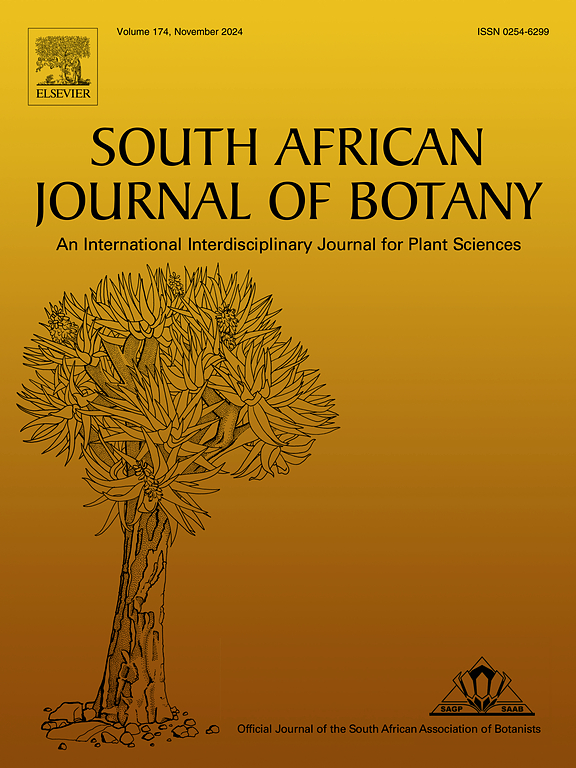Impact of heavy metal contamination on growth, Bacoside A production, and biochemical processes in Bacopa monnieri: Implications for herbal medicine quality
IF 2.7
3区 生物学
Q2 PLANT SCIENCES
引用次数: 0
Abstract
Medicinal and aromatic plants, such as Bacopa monnieri, are essential for healthcare and biodiversity. However, heavy metal (HM) contamination from industrial, agricultural, and mining activities affects their growth and therapeutic properties by altering metabolic pathways and secondary metabolite production. Since some HMs act as micronutrients, their imbalance can significantly impact plant health and medicinal quality. This study examined the effects of copper (Cu), zinc (Zn), and manganese (Mn) contamination on B. monnieri explants, which were cultured on Murashige and Skoog’s (MS) medium with varying concentrations of these metals. After 10 weeks, regenerated shoots were analyzed for chlorophyll, protein, antioxidative enzymes, malondialdehyde, hydrogen peroxide, total phenolics, and Bacoside A content. Statistical analysis was conducted using ANOVA and Tukey’s test. Results of the study indicate that altered HM concentrations significantly affected plant growth (shoot number, fresh and dry weight), biochemical responses (lipid peroxidation and antioxidative enzymes), and the production of Bacoside A, a key therapeutic compound. Compared to the control (0.535 ± 0.005 % w/w), Bacoside A levels were lowest under Cu deficiency (0.176 ± 0.007 % w/w), followed by Mn (0.271 ± 0.005 % w/w) and Zn (0.459 ± 0.009 % w/w) deficiencies. The study demonstrates the crucial role of trace element balance secondary metabolite synthesis, directly influencing the therapeutic quality of medicinal plants. Both deficiencies and excesses of HMs disrupt these processes, reducing medicinal efficacy. To ensure the production of high-quality herbal medicines, controlled cultivation practices with optimized metal concentrations are essential. This study highlights the importance of monitoring and managing HM levels in medicinal plant cultivation for enhanced therapeutic value.
重金属污染对马齿苋生长、马齿苋苷A生产和生化过程的影响:对草药质量的影响
药用和芳香植物,如假马齿苋,对医疗保健和生物多样性至关重要。然而,来自工业、农业和采矿活动的重金属污染通过改变代谢途径和次级代谢物的产生来影响其生长和治疗特性。由于一些HMs作为微量营养素,它们的失衡会严重影响植物的健康和药用质量。本研究考察了铜(Cu)、锌(Zn)和锰(Mn)污染对monnieri外植体的影响,这些外植体在不同浓度的Murashige和Skoog (MS)培养基上培养。10周后,对再生芽进行叶绿素、蛋白质、抗氧化酶、丙二醛、过氧化氢、总酚类物质和马尾草苷A含量的分析。统计学分析采用方差分析和Tukey检验。研究结果表明,HM浓度的改变显著影响了植株的生长(芽数、鲜重和干重)、生化反应(脂质过氧化和抗氧化酶)以及关键治疗化合物马齿苋苷A的产生。与对照(0.535±0.005 % w/w)相比,铜缺乏条件下Bacoside A水平最低(0.176±0.007 % w/w),其次是锰(0.271±0.005 % w/w)和锌(0.459±0.009 % w/w)。研究表明,微量元素平衡对次生代谢物合成具有重要作用,直接影响药用植物的治疗品质。HMs的缺乏和过量都会破坏这些过程,降低疗效。为了确保生产高质量的草药,必须控制种植方法,优化金属浓度。本研究强调了在药用植物栽培中监测和管理HM水平对提高治疗价值的重要性。
本文章由计算机程序翻译,如有差异,请以英文原文为准。
求助全文
约1分钟内获得全文
求助全文
来源期刊

South African Journal of Botany
生物-植物科学
CiteScore
5.20
自引率
9.70%
发文量
709
审稿时长
61 days
期刊介绍:
The South African Journal of Botany publishes original papers that deal with the classification, biodiversity, morphology, physiology, molecular biology, ecology, biotechnology, ethnobotany and other botanically related aspects of species that are of importance to southern Africa. Manuscripts dealing with significant new findings on other species of the world and general botanical principles will also be considered and are encouraged.
 求助内容:
求助内容: 应助结果提醒方式:
应助结果提醒方式:


